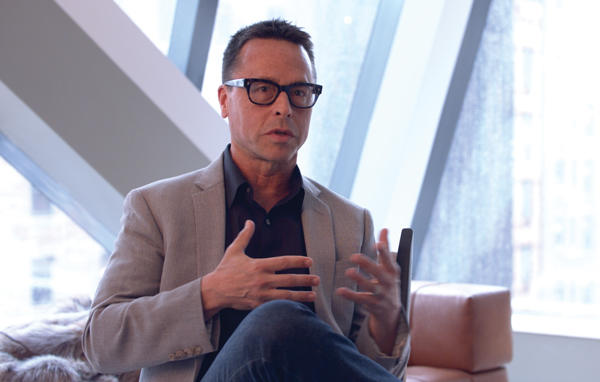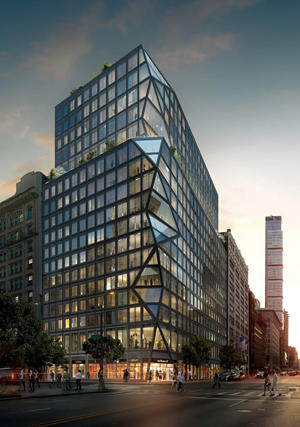Trending
Talking to Toll
David Von Spreckelsen on 121 East 22nd, the first ground-up Manhattan project by OMA, starchitect Rem Koolhaas’ Dutch firm

David Von Spreckelsen is the head of Toll Brothers City Living, the urban arm of the national homebuilder Toll Brothers.
The company is currently selling out seven buildings in New York, including 91 Leonard, 55 West 17th Street and the 140-unit block-through site at 121 East 22nd, which sits at the corner of 23rd and Lexington Avenue.
The last of those buildings officially opened last month and is currently selling units for between $1.7 million and $9.5 million. The tower has a $450 million projected sellout and is the first ground-up Manhattan project for starchitect Rem Koolhaas’ Dutch firm, OMA.
OMA partner Shohei Shigematsu, who heads up the firm’s New York office, was the lead architect on the project, which is marked by a signature twisted, prism-like punch-out at its most high-profile corner.
TRD sat down with Von Spreckelsen — whose firm has been aggressive about incentives for buyers and brokers since the New York market started softening — after a tour of building. Below is an edited and condensed version of the conversation.
How did you connect with OMA? When we bought the site, I was thinking I wanted to do great architecture and to hire somebody who would be somewhat prolific. We wanted an international firm because buyers were increasingly international. I also wanted somebody who wasn’t necessarily doing a lot of projects in New York. But knowing it’s not easy to work with an international firm — when you have the time difference and the distance — I wanted a firm that was in New York. I basically cold-called OMA and said, “I have a project. I want to come in and talk about it.” They probably, at the time, looked up Toll Brothers, and there probably wasn’t a lot on us at the time in terms of urban. They probably saw our single-family stuff and were wondering what I was doing there.

121 East 22nd Street
Could you set the scene for that first meeting? I went down to their office. There were some associates there, but the principal, Shohei Shigematsu, wasn’t there yet, so we sat around, tried to make a little bit of small talk. But again they were like, “What is Toll Brothers doing here? What have they done in New York at this time?” because this is back about 2012, I would say, and I don’t know, maybe it was 2014. Then Shohei came in and they got an understanding of what we wanted to do, and eventually we signed a contract.
Would you go with an international architect again? It really depends. There [was] a time when I think buyers [were] really gravitating towards that, when it was sort of a new concept. There’s other times when buyers are more interested in just getting the best deal. I think we would have to gauge it by what the market is like, but we had a very good experience. We have certain buyers who come in here and say they are buying here only because of that. So there is an advantage, you just have to make sure you do it correctly at the right time.
What do you think of the market right now? There was a time where you were able to sell very quickly at the price that you named. It’s different now. It’s more of a challenge. Your product has to be great. You have to really know your buyer and what amenities and finishes they want. Then you have to be nimble and flexible with regard to incentives and pricing. Luckily, we’re pretty well positioned because we didn’t buy anything at the peak. We build ourselves and we sell ourselves, so we have a way of controlling costs and we can compete on pricing when that is necessary. We’ve been selling well. We’ve got about seven buildings on the market right now, and we’re getting through the inventory.
Some developers, including Gary Barnett, have offered to pay for common charges as a buyer incentive. What are your thoughts on that, and has Toll done it? When you open a building initially there’s a time when the developers pay the common charges because it doesn’t make sense to start charging the buyers, because then you have to pay the actual number in the offering plan. It makes sense just to pay actual expenses. He was going to be paying the actual expenses anyway, so now he’s saying that’s your incentive. … I think we probably did that in here at one point. We’ve also done things with paying a certain number of years of taxes. There’s a variety of things you can do, but yeah, that is something we have done in the past and we could do in the future. … Other incentives are paying transfer tax and mansion tax, and that’s a common thing. It depends on the unit, the buyer and if you’ve got velocity or not, but we’ve sold many units here at full price.

What do you think about the new mansion taxes and the political climate? You know it’s not helpful to have this extra charge. It’s an extra cost that’s gotta be borne by somebody, and in a market where you’ve got supply exceeding demand, often the developers … are going to have the burden of paying those extra costs. There’s nothing we can do about it, but it doesn’t help.
There have been some developers who’ve lobbied. Is that something that you and Toll engage in? The lobbying, we weren’t necessarily involved in it because the lobbying initially was in regard to the pied-à-terre tax, which wouldn’t have a big effect on us. We don’t do a lot of units that are over $25 million, and we primarily sell to people who are going to be living in the units. So when that was being debated, we were kind of on the sidelines. Then there was the switch when at the last minute they decided to do it in a way that they felt would be less onerous.
Where do you guys see your NYC portfolio going in the next, say, five years? Everything we have in our pipeline right now we have out for sale. We’ve got [our] seven buildings where we’re selling units right now. A number of them have just a few left, and those will probably be gone in the next couple of months. Some of the other ones will be selling for a while. But again, there is still strong demand. People still want to live in New York, buy in New York, and we will get through.
What about any new projects? Are you holding off of those until things change, or do you feel like this is actually the moment to acquire? Well, in terms of new projects, the last one we opened was last October, 77 Charlton. We don’t have anything else in the pipeline. So we are looking and we are hoping to do probably a couple of acquisitions this year, and then we’ll have buildings coming to the market in the upcoming years.




